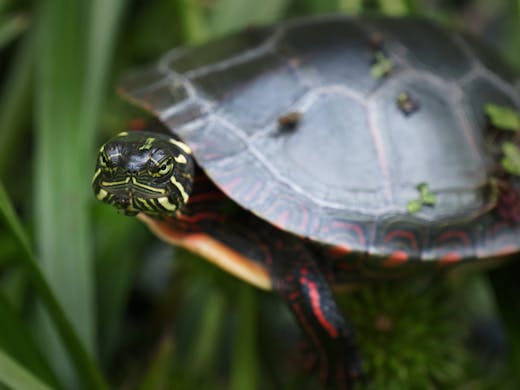Painted Turtle Chrysemys picta
Common turtle endemic to the area. Beautiful painting on skin and carapace. Loves to warm up on tree trunks and stones reaching out of the water surface.
Specs
| Length | 10-25cm |
| Weight | 0.5-1.5kg |
Common Names
| German | Zierschildkröte |
| English | Painted Turtle |
| French | Tortue peinte |
| Spanish | Tortuga pintada |
Taxonomy
| Order | Testudines |
| Family | Emydidae |
| Species | Chrysemys picta |
Advertisement
We need your help! By making a contribution towards our hosting costs, you can help us provide an ad-free experience on our website in the near future. Paypal
How to Identify
Very similar to the Northern Map Turtle. Identifiable due to the red colors on skin and carapace.
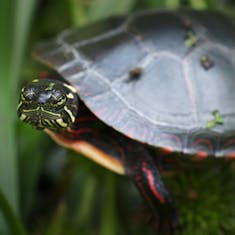

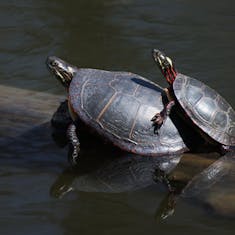
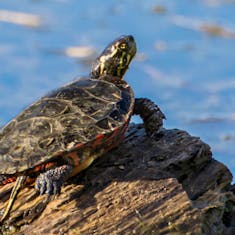
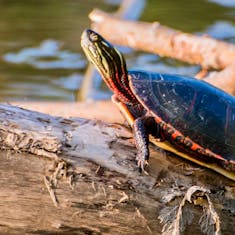
Photography Tips
An aquatic species spending much of its active time swimming in a pond searching for food. Specially during early spring, the turtle loves to sit on a trunk or stone reaching out of the water and warm up.
Photographing this species presents several challenges. Painted Turtles, being shy creatures, tend to quickly dive away when approached too closely. To capture a frame-filling photo, use a minimum 200mm lens and approach them cautiously. Be mindful of water reflections and overexposed areas, especially on sunny days. Additionally, achieving a camera position at water surface level, though desirable, may not always be feasible in most parks.
We recommend Jardin Botanique de Montréal as best option. The ponds in this park allow you to get close to the water and at water surface level.
Painted Turtle Trivia
Is the Painted Turtle an endangered species?
No, this turtle species is not endangered; it is a widespread and common species in North America with stable populations. Their adaptability contributes to their presence in various environments, both natural and human-altered.
Is the Painted Turtle native to North America?
Yes, the turtle species is native to North America. It is one of the most widespread and common turtle species on the continent. Painted Turtles are found in a variety of aquatic habitats, including ponds, lakes, slow-moving rivers, and marshes, throughout much of North America.
Does the Painted Turtle have a long lifespan?
No, this species has an average lifespan compared to other turtle species. However, its lifespan is relatively long compared to some non-turtle animals. Painted Turtle individuals in the wild can live up to 20-30 years.
Does the Painted Turtle hibernate in Winter?
Yes, this turtle species undergoes a period of hibernation during winter. They typically burrow into the mud at the bottom of ponds or slow-moving waters, where they enter a state of torpor, slowing down their metabolism to survive the colder months.
Is the Painted Turtle the smallest turtle in North America?
No, this species is not the smallest turtle in North America. The Bog Turtle holds that distinction, being one of the smallest turtle species on the continent. Painted Turtles are of moderate size, with females generally being larger than males.
Can the Painted Turtle retract its head and limbs?
No, this species of turtle has a rigid shell that does not allow for complete retraction. Its main defensive strategy involves swiftly retreating into the water when on land or resting on rocks or logs.
Is the Painted Turtle a herbivore?
No, this turtle species is not strictly herbivorous; it is omnivorous. While it does consume aquatic plants, it also includes insects, small invertebrates, and sometimes small fish in its diet.
Does the Painted Turtle have teeth?
No, this species does not have teeth. Instead, they have a sharp, beak-like structure adapted for their omnivorous diet, which includes aquatic plants, insects, and small invertebrates.
Does the Painted Turtle exhibit sexual dimorphism?
Yes, this species exhibits sexual dimorphism. Female Painted Turtles are generally larger than males, and they have a broader, more rounded carapace, while males typically have a smaller and more streamlined appearance.
Does the Painted Turtle female lay eggs every year?
Yes, female Painted Turtles typically lay eggs every year. They usually select sandy or loose soil near their aquatic habitat to dig a nest, where they deposit a clutch of in average 6 to 10 eggs.
Are Painted Turtle parents involved in parenting?
No, Painted Turtle parents do not exhibit parental care. Once the female lays her eggs in a nest, she covers them and leaves, providing no further care to the eggs or the hatchlings. The offspring are independent from the moment they hatch.
Are Painted Turtles popular among park visitors?
Yes, Painted Turtles are popular among park visitors due to their vibrant colors and distinctive markings. Observing these turtles basking on logs or swimming in ponds adds to the overall appeal of natural habitats for park-goers.
Where and When to Spot
Can be seen in different parks along Saint Lawrence River spring, summer and autumn.
| Spring | Summer | Fall | Winter | |
|---|---|---|---|---|
| Jardin Botanique de Montréal | x | x | x | - |
| Parc Angrignon | x | x | - | - |
| Parc Bernard-Landry | x | - | x | - |
| Parc Michel-Chartrand | x | - | - | - |
| Parc de la Frayère | - | x | - | - |
Where and when a species has been observed, identified, and recorded.
